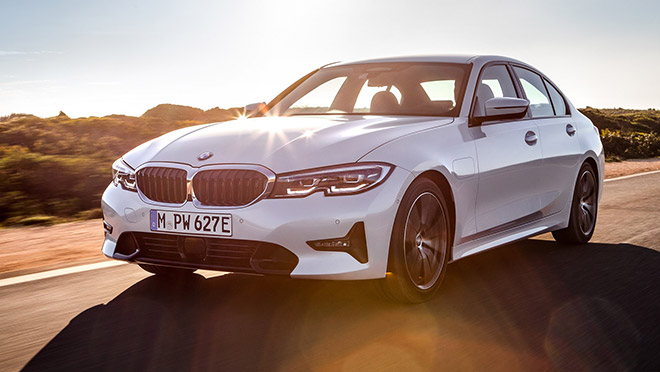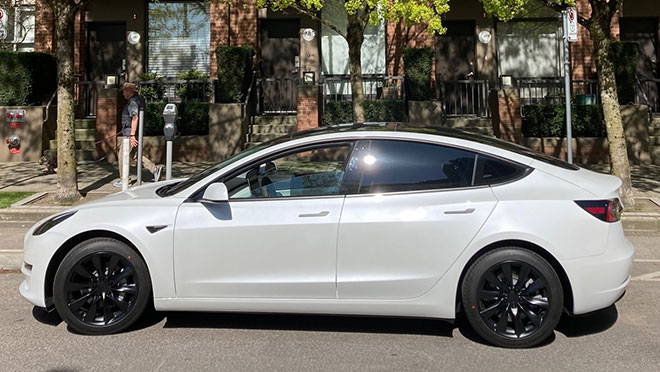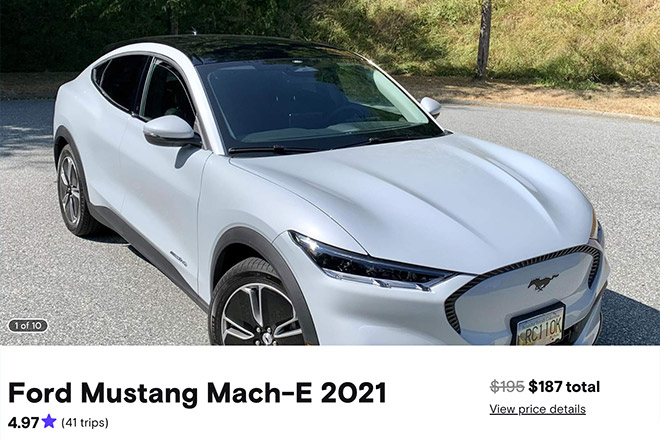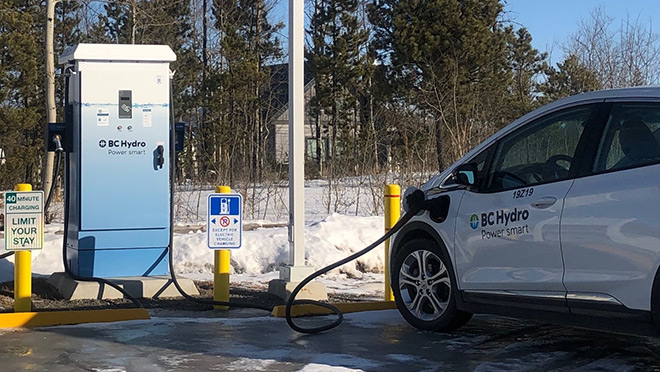Stylish Kia EV6 delivers as a dazzling crossover SUV
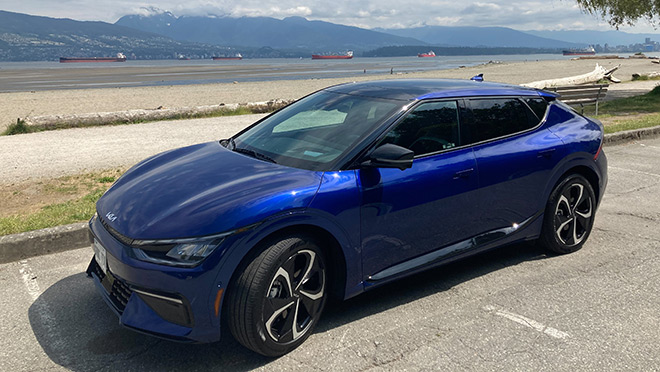
Kia's flagship electric turns heads, takes aim at Tesla's dominance
Rob Klovance
For bchydro.com
This article was updated on July 7 to correct an error in a gas-powered vehicle CO2 emission calculation.
First there was a big thumbs-up from the neighbour who's no stranger to driving pricey supercars.
At intersections, there were head-turning glances from impressed pedestrians.
And to top it off, there was a "Wow!" from my 18-year-old son who – after a spin in the Kia EV6 – suddenly recruited Dad to be chauffeur on prom night.
The EV6 is pretty much everything the South Korean carmaker had promised when it boldly marketed the sleek and sporty crossover electric long before it was released. It's a moderately priced deluxe EV, starting at $45,000 and qualifying for $8,000 in combined federal/provincial rebates for all models (including the $62,000 GT Line 2 tested) currently available in B.C.
The EV has the look, inside and out, plus the range (373 km to 499 km, depending on the model) and drivability to take a serious run at its most natural rival, the Tesla Model Y. And while it's not going to be a fit for everyone hungry for an alternative to the faster and roomier Model Y – Canada's top-selling electric SUV – it's a worthy challenger.
Kia's designers knock out it out of the park with the EV6
If you're under the impression that Kia is a maker of basic, unremarkable cars, you need to drive one. There's a quality of design here, and a sterling track record for reliability, that makes the sister company of Korean automaker Hyundai a real player.
As much as I was impressed by the Kia Niro EV I drove last year, the EV6 is a distinct step up, especially in the feature-laden GT-Line 2 model I was treated to for a week in June. There's nothing like all-wheel drive, 20-inch wheels, and a delightful high-tech interior to convince you that Kia is taking its design cues more from German automakers than it is from any North American rivals.
The vehicle’s dashboard is a delight, with a combination of touchscreen operation and analog buttons/dials to feel future-forward without being intimidating. It's a much easier transition from a gas-powered vehicle than the analog-free, no-buttons approach of the Tesla's central LED rectangle, although most Tesla owners will tell you they love the do-everything-in-one-place functionality once they get used to it.
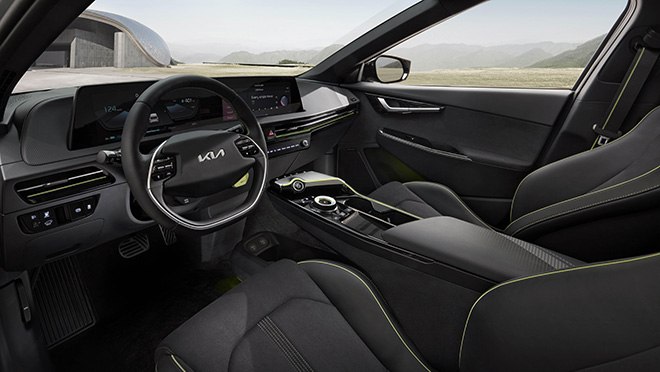
A first-class cockpit, and a lot of smart touches
Highlights in the EV6 cabin include the round blind-spot video that pops up when you activate the turning signal for a lane change or turn, either to the left or right of the central speed/range instrumentation. It's all viewable through your steering wheel, and you still get a blind-spot-detecting amber blink in your side mirrors as an alert. There's also Apple AirPlay, albeit it via USB plug-in instead of Bluetooth, and a big central storage area to plunk extra keys, wallets, and even snacks, near the floor.
The steering column offers an array of handy audio and other controls, including paddle shifters on either side that allow you to quickly shift the amount of regenerative braking, from zero to three. On a round-trip to Whistler, I got much better range, and almost complete one-pedal driving (no brake necessary) with the regen cranked up. It's pretty cool to cruise down a hill and watch your range estimate climb.
The little things impress as well. While it takes a while to get used to the warning beeps that activate when you get near a centre line, or while parking, I liked that when I was trying to squeeze into or out of a tight parking space, the stereo volume turned down automatically until I no longer needed full concentration and it went back to full volume.
Other nice touches: I love the rear seat air vents and USB outlets, one on each side, plus the power source plug at foot level in the back. Everything's well thought out, including the use of Velcro strips to secure charge cord and tire mobility kits to the carpeted floor of the cargo area. Even though there's space in the hideaway storage area beneath the main cargo area, I left both rectangular bags up top and used them to secure groceries, including a dozen eggs, in a corner of the cargo area. Brilliant.
And then there's the tire mobility kit itself. While other companies such as BMW increasingly rely on run-flat tires instead of spare tires to allow you to drive a short distance to a garage or dealership, Kia equips the EV6 and other models with a kit that includes a tire sealant and compressor – powered of course by the vehicle's battery pack – to temporarily fix and inflate a flat tire. I would have loved that option when I got stranded east of Hope – too far to travel on a run-flat tire – by a flat in a BMW 330e hybrid last summer.
The EV6's sleek styling and low roof, however, lead to a trade-off that will not work for some. While I was able to adjust the driver's seat to give me comfortable clearance for my head (I'm a six-footer), taller drivers have struggled to find headroom. And while legroom is great in the backseat, there's limited headroom for anyone over six feet.
Cargo space in the EV6, especially with the back seats folded flat and the retractable cargo cover removed, is going to be adequate for most people. At 1,415 square litres with the seats folded down, and a ski-through fold-down between the back seats, there's decent room and options, including an adjustable cargo floor to help add a bit more space. But it's a smaller cargo space than competitors – or the boxier Hyundai Ioniq 5 built on the same EV platform as the EV6 – such as the Mustang Mach-E (1,637 square litres) and the Model Y (1,925 square litres). As for the frunk (cargo space under the hood), there's very little room compared to many EV rivals.
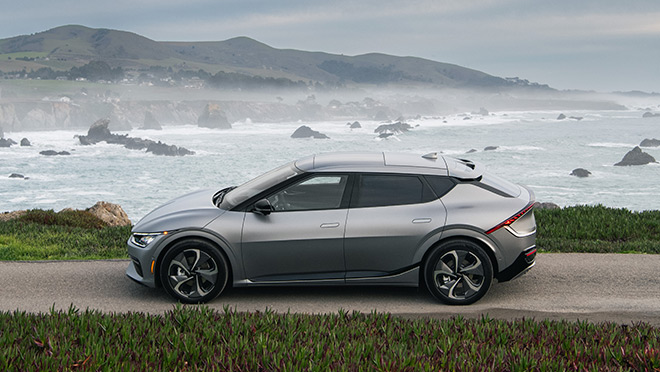
Drive is a nice balance between sport and comfort
On a drive from Vancouver to Whistler, the EV6 checks all the boxes with a combination of power – 0 to 60 acceleration in 5.2 seconds – and agility. The car's suspension is softer than the Model Y's, so there's a mild roll while taking curves at high speed. It's not a road-hugging sports car marvel, but it's fun to drive. The heady blend of comfort and power should appeal to a broader audience than with some sportier EVs with firmer rides.
For those wondering how the EV6 performs in a Canadian winter, there's a detailed driving.ca review that's pretty much a rave about how the all-wheel drive version shines in snowy, slippery conditions. And ev-database.org pegs the long-range EV6's winter range – tested at -10°C with the heat on – at a combined 340 km compared to a summer real-world range estimate of 570 km in the city, 370 on the highway, and 460 combined.
For Canadian drivers, Kia offers a heat pump option that both extracts heat from outside air and recycles waste heat from the vehicle to maintain cold-weather range.
As tested, the GT Line 2 all-wheel-drive model I drove has an MRSP of $61,995, but it qualifies for the combined federal and B.C. $8,000 EV rebate because the EV6s base model – starting at $44,995 – is below the maximum price rebate cutoff. Budget-minded drivers who still want the bigger battery and AWD can opt for the Wind package at just under $55,000. The full GT version of the EV6 – the one that promises a 0-to-60 sprint of less than 3.5 seconds – will be available in Canada later in 2022.
I drove the GT Line 2 model aggressively for a week and logged 475 km, with range varying greatly between city driving and a speedy run to Whistler. Without an EV charger in my apartment building I topped up twice at fast chargers in Vancouver and paid about $24 to travel those 475 km. If I was charging at home, the per-kWh cost would have been less than half the fast charge rate, or about $12. Not bad, considering I'd be paying around $100 to drive the same distance in my day-to-day gas-powered ride, a 2016 Mazda CX-5.
In 46 minutes plugged into a 50 kWh fast charger, I added 38 kWh to the EV6, or enough to go about 200 km.
If I was able to plug-in at a Level 2 charger at home for 80% of my charging for my usual 15,000 km per year, even allowing for lower range in winter I wouldn't likely spend more than $500 annually to charge the EV6. Even if gas prices cooled to an average of $1.75 per litre over the year, driving my CX-5 would cost me $2,000 more per year in "fuel" charges. And the Mazda will spew out more than 15,000kg in CO2 emissions burning gas over five years.
What I liked
- Sleek exterior and fabulous interior
- Blend of touchscreen and analog instrumentation
- Pop-up video, right in front of the driver, when making turns and lane changes
- Power, handling and comfort
What I didn't like
- A few too many buttons, including some at the front of the centre console that can be activated by accident, and front-seat USB outlets that require a full stretch to plug into near floor level.
- Interior headroom challenges, especially in back seat, for taller passengers
- Small storage space 'frunk' under the hood compared to competitors
The verdict:
There's a good reason the EV6 was named 2022 European car of the year in a vote by motoring journalists. It's a stunning option for those who might otherwise consider the Tesla Model Y or Mustang Mach E, and it's right up there in bang-for-your buck with the excellent Ioniq 5 that's the roomier, less sporty version of the EV6 from Kia's sister company Hyundai.
Related:
